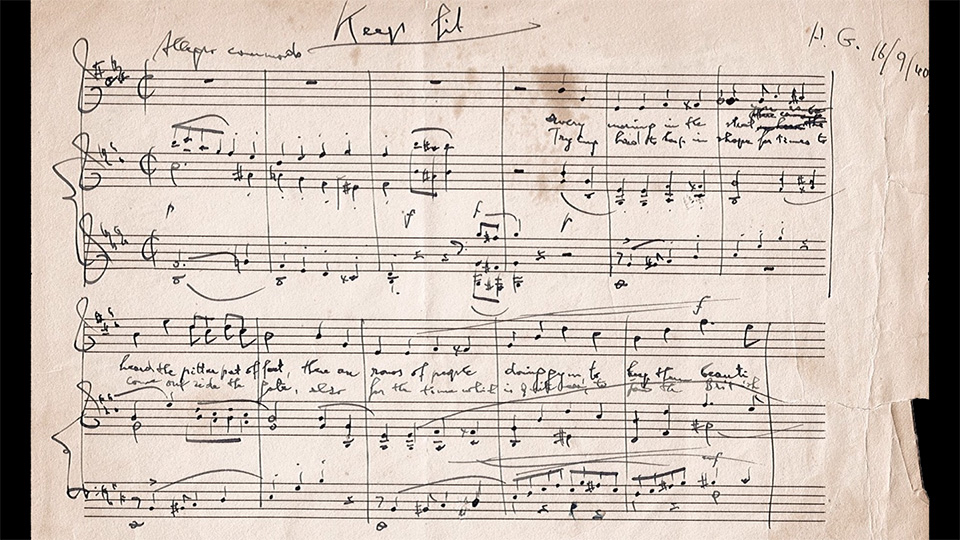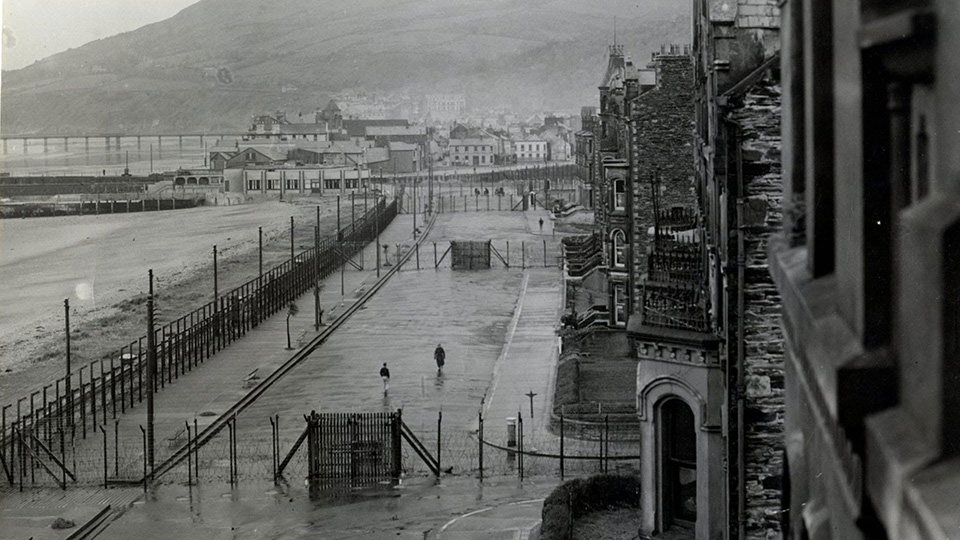The composer Hans Gál (1890-1987) was almost 50 years old when he was interned. He had enjoyed considerable success as a composer in Vienna in the 1920s and had been appointed Director of the Conservatory in Mainz in 1929. After his dismissal by the Nazis in 1933 he returned to Vienna but was forced to emigrate to Britain after the annexation of Austria in 1938. He and his family had found refuge in Edinburgh, but like most of his fellow internees he was arrested on Whit Sunday in May 1940. He was first brought to Huyton near Liverpool and then to the Isle of Man.
There Gál became a leading member of the arts committee at Central Camp in the capital Douglas. After several successful concerts of classical music, the arts committee decided to put on a comic revue to provide much needed light entertainment. It was the brainchild of the Austrian film director Georg Höllering (1897-1980), who had worked with Berthold Brecht on the film Kuhle Wampe in 19322. He asked Gál to compose the music for it and called it What a Life!

Hans Gál, 'Keep Fit' from What a Life!, manuscript detail, reproduced with kind permission from Eva Fox-Gál
Gál wrote the music of the revue from his bed in the camp hospital, where he was suffering from a severe skin allergy. He was awaiting his imminent release due to medical hardship. When it finally came, Gál asked to be allowed to stay an extra day so he could conduct the second performance. The camp commander found this 'very sporting' and gave permission. Both sold-out performances took place at the Palace Theatre in Douglas, a large venue with a proper stage and orchestra pit. Performers and audiences were given special permission to go to the theatre which was outside the camp boundaries. The first performance on September 2 was followed by a substantially revised and extended second performance on September 26.
Höllering, an experienced film producer, had succeeded in involving countless volunteers in a quick succession of varied tableaus and group scenes with stage designs, interspersed with scenes in front of the curtain. There were two compères, one speaking German the other English, and two main singers, a baritone and a tenor. During a grand parade, presumably the Einzugsmarsch, the entire hierarchy of the camp including the camp council, the house fathers and the hospital doctors appeared on the stage. The songs are parodies of actual life in the camp, making fun of the seagulls, the barbed wire, the gender separation, the fitness routine, cleaning up, sharing double beds and observing the blackout. Sadly, not all of these songs survive. There are some fragments of songs in the manuscript that could not be reconstructed, including a Porridge Elegie.
‘Keep Fit’ from ‘What a Life’
Performed by Peter Kirk and other students at the Royal College of Music in 2012
For the second performance, Höllering and Gál added three numbers: the Ballade vom Deutschen Refugee, the Ballade vom armen Jakob and the Quodlibet. The last of these had been entirely improvised in the first performance as a parody of the many musicians practicing in the camp who made an unbearable noise. For the second performance, Gál decided to compose this in counterpoint, using musical quotations that could be recognised by connoisseurs. The Ballade vom Deutschen Refugee was half spoken, half sung by an actor playing a harp strung with barbed wire while sitting on a crate of porridge, with cardboard cut-out figures appearing behind him. It was interspersed throughout the revue in three instalments with four verses each time. The other new piece, the Ballade vom armen Jakob by Norbert Elias, was performed by a speaker and a chorus from the youth group of the camp, with group scenes and shadow backdrops to illustrate the story.
Unfortunately, the text of the spoken dialogue scenes that were performed between the musical numbers does not survive. What we do have are the songs and instrumental numbers from Gál’s manuscripts, and his wonderful diary Music behind Barbed Wire, which recounts the whole episode of internment and the creation of the revue in great detail. In our performances we interspersed the songs with relevant excerpts from Gál’s diary to put them in context. The order of songs was also slightly re-arranged to better incorporate these diary excerpts. The excerpts have been included in our critical edition, in both English and German, with kind permission from the composer’s daughter Eva Fox-Gál.3
‘Quodlibet’ from ‘What a Life’
Performed by Tim Nelson and other students at the Royal College of Music in 2012
After his release from internment, Gál composed Suite from What a Life! for solo piano. It was never published and only ever performed by him and fellow émigré pianist Edith Vogel. It is dedicated 'To all my dear friends from Central Camp, Douglas, Isle of Man'. We are pleased to have been able to include it in our edition.
After internment Hans Gál returned to and settled in Edinburgh, where he composed more than half of his entire oeuvre. He became a well-known personality in the musical life of the city as composer, performer, scholar and teacher and remained active until his death in 1987. His music is available from major publishers including Universal Edition, Boosey & Hawkes, Breitkopf & Härtel and Schott. It has enjoyed considerable interest in recent years, with major recordings and opera productions in Britain and Germany making it more accessible and better known to performers and audiences alike.
Download our Critical Edition of ‘What a Life’ here









